“NEW” INVASIVE THRIPS SPECIES: Thrips parvispinus
I’m hesitant to use the term “breaking news,” because this story broke months ago in relation to ornamental and vegetable growers in North America and has been on the radar of pepper growers for a few years. Let’s instead call it a “rapidly evolving story.” Many emails and texts have crossed my desk this week asking for info and resources on Thrips parvispinus, an invasive thrips species causing major issues in Florida and which appears to be heading north.
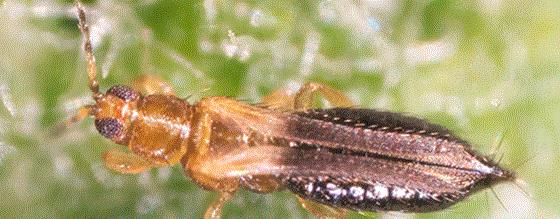
Here's a description of the pest from a recent blog post by Tory Moore, PR specialist with University of Florida's Institute of Food and Agricultural Sciences (IFAS):
The insect, Thrips parvispinus—commonly known as pepper thrips—is one of the smallest thrips species in Florida. Its size makes it challenging to detect. The tiny insects fly and hop from plant to plant, rasping the plant with their mouth parts and sucking the sap. Feeding by the thrips restricts the plant’s growth and reduces crop yields. Researchers don’t know of any viruses this species transmits; but thrips can often transmit viruses between plants, killing the plants.
The title of this newsletter item uses the word “new,” but from what I’ve learned, this particular species has been reported around the world for decades. I’ll be referencing UF/IFAS experts a lot, as they seem to be leading the research into this pest. Here’s what they say about its history:
Thrips parvispinus is native to the Asian tropics and has been reported being present in at least 17 countries (Burundi, China, India, Indonesia, Japan, La Reunion, Malaysia, Mauritius, Myanmar, the Netherlands, Philippines, Singapore, Taiwan, Tanzania [Dar-el-Salam], Thailand, Uganda [Kampala], USA [Hawaii]) and intercepted in at least ten countries (Australia, France, Greece, New Guinea, New Zealand, Solomon Islands, Spain, Switzerland, the UK) from five continents (Africa, Asia, Australia/Oceania, Europe and North America) in the last three decades.

JC Chong on Thrips parvispinus
My fellow newsletter editor (I hope you’re subscribed to PestTalks!) and pest expert JC Chong started talking about Thrips parvispinus in January, based on reports from growers. He's done an excellent job explaining how to ID the pest:
An adult female Thrips parvispinus has a brown head, yellowish or light brown thorax, and dark brown or black abdomen. Males are smaller and entirely yellow. Keep an eye out for thrips that mainly damage leaves, stems and flower petals, and doesn’t look like western flower thrips (yellow in color), chilli thrips (yellow), echinothrips (black with white band), and onion thrips (color ranges from yellow to brown, without a band on thorax). They may be Thrips parvispinus. Now, I said “may be” …
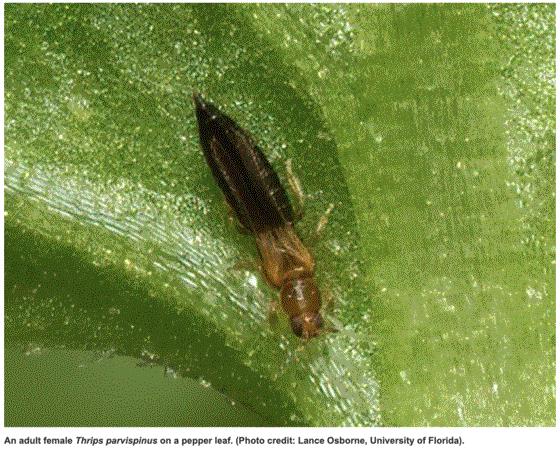
Distinguishing one thrips species from another sound simple, right? No, it’s actually not simple. Because so many of the thrips species look alike, it’s best to send in samples and let the experts at your local diagnostic service identify the thrips to species. That way, you’ll have the confidence in knowing that the diagnosis is done right, and your management plan is tailored to achieve success against the damaging species.
Currently, it’s difficult to develop a management plan for this thrips species because information on the efficacy of insecticides and biological control agents isn’t available. What growers in Florida do is throw the kitchen sink at the thrips. Based on the data I have on other foliage-feeding thrips species, mainly chilli thrips, echinothrips and other thrips species, I think Conserve (spinosad), Avid (abamectin), Pylon (chlorfenapyr), Mainspring (cyantraniliprole) and Hachi-Hachi (tolfenpyrad) are good options. It is reported that some growers have found success with Orthene (acephate), Pedestal (novaluron), Hachi-Hachi, and XXpire (spinetoram + sulfoxaflor).

Nick’s Tip of the Week: Frequent Phyto Flyers
Let’s take a quick break from thrips … We can continue after Nick’s Tip.
Each week, I’ll work with my buddy Nick Flax, a technical services expert at Ball, to share a concern that’s come up during one of his numerous calls with growers across North America. This week, he’s been working with growers seeing phytotoxicity symptoms on crops.
PROBLEM: When your greenhouse is packed to the gills and finished material is really starting to ship, it can be difficult to keep track of the small things. What got sprayed and what didn’t? Which fungicide did I use? What rate did I use? These are all questions that quite a few growers I’ve worked with these last few weeks have asked themselves when they reported odd symptoms appearing in their crops.
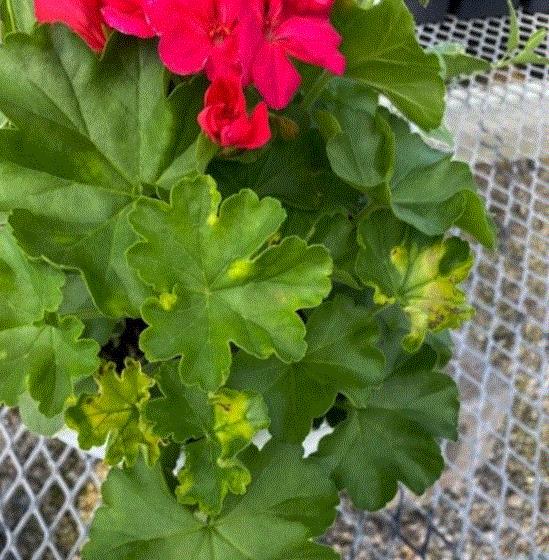
NICK’S TIP: This week, we’re going to review a few common causes of phytotoxicity that have been occurring recently in North American spring crops and how to avoid these issues in the future.
Note: trade names will be emphasized in this week’s tip, but these are not meant to be criticisms of the products mentioned. In fact, it is my hope that specific mentions here will help build awareness of common errors made with these products out in the greenhouse and help you all to be more successful with them in the future.
Fungicide Phyto
One of the harder-hitting fungicides in the bedding plant grower toolbox is fludioxonil, more commonly known and sold as Medallion (a FRAC 12 fungicide). This is one of my go-to fungicides for managing pathogens like Fusarium and Rhizoctonia, but it also has broader use in combating Botrytis and several fungal leaf spot pathogens. However, there are a couple of crops that Medallion should never be applied to, and the label specifically cautions applicators against doing so: namely geraniums (any Pelargonium spp.) and New Guinea impatiens. Stunting, chlorosis, and/or distortion are typical symptoms that result when applied to these two crops, and the only real path forward is to push through the stunting and flush new growth out over damaged foliage.
-
Most often when this occurs, the grower/applicator needed to make a quick decision on which fungicide to apply and forgot the cautionary statement on the label. While you should always thoroughly review the label of any IPM product before using it, glossing over the footnote about potential phyto is an understandable oversight.
-
If you aren’t sure if a fungicide can be safely applied to a given crop and you can’t read the fine print on the label attached to the bottle, run a quick check on the digital label. Visit the product manufacturer’s website, find the most up-to-date version of the product’s label, and open it as a PDF. Then, hit Control + F (or Command + F for Mac users) and type the common name of the crop in question and again using the Latin name, if you know it. If there are any cautionary statements regarding the crop in question, the search function will take you right to it, rather than searching line by line or potentially missing it all together.
-
While it may seem painfully simple, write “DO NOT apply to X, Y, or Z crop” on the side of the container with an industrial Sharpie for Medallion or other fungicides with similar phyto concerns on specific crops. This way, every time you take this fungicide out, there’s a highly visible reminder to avoid applying it to the wrong crops. Just be sure to rewrite the note if the marker starts to smudge or fade.
Insecticide/Miticide Phyto
Much like the crop-specific phyto concerns of Medallion, insecticide/miticide products can pose similar risks.
-
Misapplication of spirotetramat (commonly sold as Kontos here in the US) is a frequent cause behind distortion, stunting and chlorosis on finished geraniums around this time each year.
-
Kontos is a staple in many growers’ IPM toolboxes—especially for managing two-spotted spider mites and broad mites—but this one should be left out of the rotation on your geraniums and a few other tropicals/foliage plants (see the label for more details).
-
While the phytotoxicity that can result when this product is applied to geraniums looks concerning, most mature crops can push through the damage and recover within a couple of weeks. Higher dosage earlier in the crop cycle can have longer-term impact and delay time to finish, but Kontos phyto most often occurs as a later-season “oops” in the spray program. Be sure to add a “NOT for geraniums” note to the bottle for this one, as well.
The moral of the story here is this: Always read the label and take a couple of extra minutes to make sure your IPM product is safe to apply to your target crop. It’s easy to get caught up in the hectic pace of spring and grab the first thing on your chemical storage shelf, but an accidental misapplication could be the difference between getting a premium for your plants and getting them to retail a week or two late.

Back to Thrips parvispinus: FNGLA Letter to Florida Growers
To put developments related to Thrips parvispinus in perspective, here is a LETTER FROM FNGLA’S Miami-Dade Chapter president Jeffery DeMott to South Florida horticulture stakeholders.
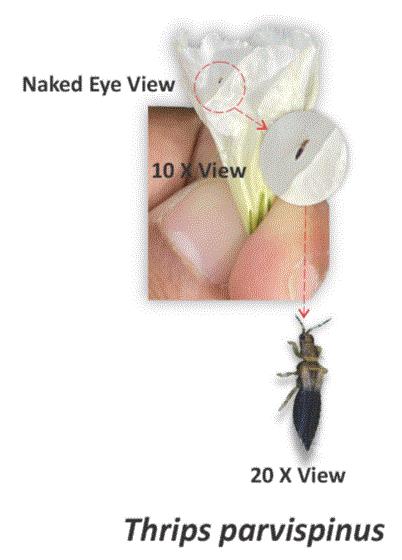
In it, he identifies the urgency of the threat posed by this pest and discusses the history of the industry’s response and ongoing efforts by the Tropical Research and Education Center, Division of Plant Industry to inspect shipments and the actions that will be taken if the pest is found.
The most disheartening part of Jeffery’s letter is a reference to 17 growers currently under quarantine (as of March 31) and expectations of more to come. As he states, this equates to millions of dollars of lost revenue and tremendous pressure placed on the industry. This is a serious concern for all involved!
Thrips parvispinus Details & Host Plants
Thankfully, a lot is known about this particular thrips (although you can expect much more research to come) and UF/IFAS has produced a very thorough DOCUMENT—UPDATED AS RECENTLY AS APRIL 11, 2023.
In the fact sheet, researchers shares a ton of details about the thrips species, including exactly what the pest looks like, damage caused through disease vectoring, and crops on which they have been reported. There’s even a three-minute VIDEO showing you exactly what to look for when IDing Thrips parvispinus.
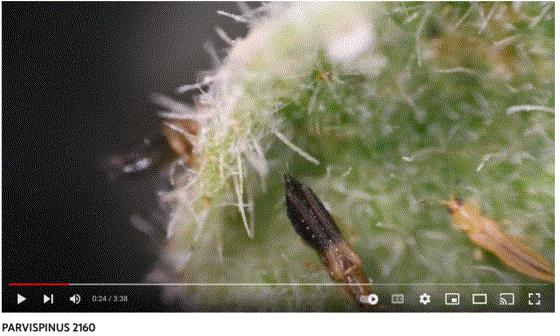
The document continues with a long list of potential host plants, including plenty of ornamental crops and vegetables. Put it this way: The list is way too long to include verbatim in this newsletter … not good!
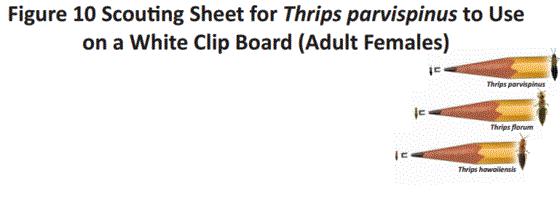
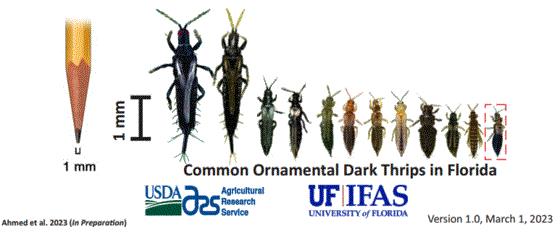
Following the host plant list, the UF/IFAS info really gets focused, with images of damage symptoms AND scouting tips.
According to the report, “scouting should be conducted by beating foliage over a white clipboard, and the number of adult and immature thrips should be counted immediately.”
To help with this, UF/IFAS has developed a PRINTABLE SCOUTING SHEET for your team to use. It has images and size references, as you can see in the photos.

FREE WEBINAR on Thrips parvispinus
The Horticultural Research Institute (HRI), in collaboration with AmericanHort, the Canadian Nursery & Landscape Association and the American Floral Endowment, is offering a free webinar on May 10 featuring three experts discussing Thrips parvispinus.
In this webinar, expect content on identification, scouting and potential controls. A question-and-answer period with the experts will occur at the end of the webinar. Based on the webinar description, three key areas will be covered:
-
History and Field Identification of Thrips parvispinus in Florida: Lance Osborne will discuss the response of USDA-ARS, University of Florida and Florida’s Regulatory Agency (FDACS-DPI) to the detection of this important pest. He will also discuss the use of observations and field guides to identify Thrips parvispinus.
-
When, Where, and How to Monitor for T. parvispinus. Thrips parvispinus causes severe damage to several types of tropical ornamental plants. Sarah Jandricic will share what damage looks like on several plant species, where the thrips like to reside on the plant, and effective ways to monitor for them in your crop.
-
Options to Manage T. parvispinus. Damage from Thrips parvispinus feeding reduces plant quality. Cristi Palmer will present outcomes from international efficacy research and options that are available in the US for thrips management.
REGISTER NOW AND PUT THIS ON YOUR CALENDAR ASAP. You definitely want to stay on top of this pest issue and the ongoing developments.

Finish Line … This Just In!
I was going to wrap up the newsletter with some motivational quotes to get you psyched up for the busy spring season, but I literally just got an email from Tech On Demand team member Dr. Nathan Jahnke with a link to a Michigan State University presentation from earlier this year by Ontario’s Vineland Research Centre scientist Dr. Rose Buitenhuis. The video covers all sorts of fantastic sanitation tips and research data on the effectiveness of dipping cuttings upon arrival to reduce pests and diseases.
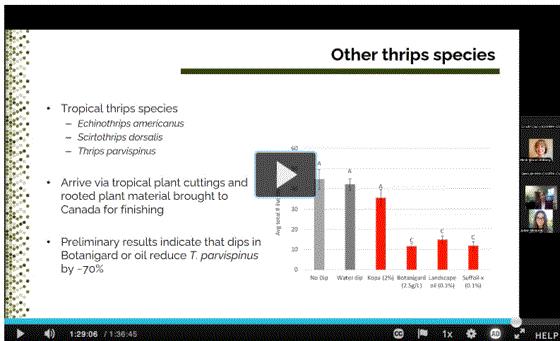
This is all important info, and you should save the 1 1/2-hour video to help your team prepare. BUT! What you need to do ASAP is CLICK THIS LINK and fast-forward to about 1 hour and 29 minutes in—to the point where Rose discusses cuttings dip strategies for tropical plant cuttings where Thrips parvispinus pests are a potential threat.
Okay … That’s the end of this week’s newsletter, which is 90% dedicated to a specific insect pest. I expect my inbox will continue to fill with Thrips parvispinus resources and chatter (although I truly hope not). Of course, as more info becomes available, I will share it with you each week.
Aside from thrips, have a great week! Weather is warming up, plants are filling stores and shoppers are either filling carts or are about to do so. Go get ‘em!



Please feel free to send your comments, constructive criticism and topic ideas to me at bcalkins@ballhort.com.

Bill Calkins
Editor - Tech On Demand
This email was received by you and 26,306 other fine subscribers!
If you're interested in advertising in Tech On Demand, contact Kim Brown ASAP and she'll hook you up.